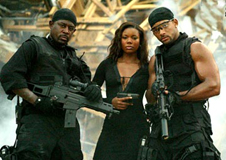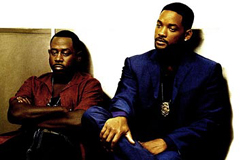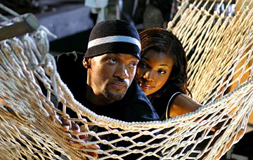Bad Boys II (Michael Bay, 2003)
 The arrival of a new Michael Bay film, perhaps
appropriately, sets forth much gnashing of teeth in the critical community, and
it doesn’t seem that the coming of Bad Boys II is any different.
Everything that one needs to know about Bay’s particular brand of cinematic
overkill can be seen in the opening sequence of the movie. Before the titular
bad boys storm onto the scene, the film spends about five minutes detailing the
operations of an ecstasy-smuggling operation. In these scenes, Bay has no idea
how to use his style to condemn the drug dealers. He films everything that they
do in the same glossy, rapid, mood flattening style that he uses to celebrate
his heroes, and as a result he ends up making the drug dealers look “cool”.
Even after he establishes his heroes (who form a generic buddy cop match-up), he
still keeps ladling the same incomprehensible, conflicted style over his
cardboard villain (Jordi Molla). Shot after shot compares him to Jesus,
presumably in the pursuit of humor, but during those scenes, the only thing
being satirized is his religious devotion. In other scenes, he features rats
running around the dealer’s mansion, and the camera seems to be suggesting
that Bay thinks the dealer is a rat, but considering the general lack of control
exhibited over such things in Bad Boys II,
I can’t be too certain of his intent. In any case, I’m completely at a loss
of what to make of the final cruelty inflicted on his villain, in which he
depicts him falling onto a land mine and exploding after he’s been shot
between the eyes. The righteous eye of Bay sees potential for suffering
everywhere, so it’s difficult to read moral judgments into his decision to
punish his villain, especially since he seems as interested in making him seem
flashy.
The arrival of a new Michael Bay film, perhaps
appropriately, sets forth much gnashing of teeth in the critical community, and
it doesn’t seem that the coming of Bad Boys II is any different.
Everything that one needs to know about Bay’s particular brand of cinematic
overkill can be seen in the opening sequence of the movie. Before the titular
bad boys storm onto the scene, the film spends about five minutes detailing the
operations of an ecstasy-smuggling operation. In these scenes, Bay has no idea
how to use his style to condemn the drug dealers. He films everything that they
do in the same glossy, rapid, mood flattening style that he uses to celebrate
his heroes, and as a result he ends up making the drug dealers look “cool”.
Even after he establishes his heroes (who form a generic buddy cop match-up), he
still keeps ladling the same incomprehensible, conflicted style over his
cardboard villain (Jordi Molla). Shot after shot compares him to Jesus,
presumably in the pursuit of humor, but during those scenes, the only thing
being satirized is his religious devotion. In other scenes, he features rats
running around the dealer’s mansion, and the camera seems to be suggesting
that Bay thinks the dealer is a rat, but considering the general lack of control
exhibited over such things in Bad Boys II,
I can’t be too certain of his intent. In any case, I’m completely at a loss
of what to make of the final cruelty inflicted on his villain, in which he
depicts him falling onto a land mine and exploding after he’s been shot
between the eyes. The righteous eye of Bay sees potential for suffering
everywhere, so it’s difficult to read moral judgments into his decision to
punish his villain, especially since he seems as interested in making him seem
flashy.
 Because he’s so eager to get the audience involved, Bay
exaggerates everything in sight, hoping to make it interesting. It’s not
enough to show drugs being smuggled. Here the drugs being smuggled are
transported in coffins. It’s not enough that the dope smugglers are evil. Here
they are also members of the Ku Klux Klan. It’s not enough to have a gruff
police squad leader barking orders. Here he’s played by Henry Rollins. Because
Bay is completely incapable of turning off this “gift”, though, nothing
really registers as cool. Worse still, since everything is being given the same
treatment by the style, nothing ever really registers as exciting. Not for a
single moment is the film suspenseful, but it still maintains a stoicism in its
action scenes that keeps it from feeling fun. A multitude of lame comedy skits
exist to break up the set pieces, but they are infused with the same sort of
mean-spiritedness that defines the rest of the picture. To find them funny is to
buy into Bay’s homophobic, masochistic, and generally rotten view of the
world.
Because he’s so eager to get the audience involved, Bay
exaggerates everything in sight, hoping to make it interesting. It’s not
enough to show drugs being smuggled. Here the drugs being smuggled are
transported in coffins. It’s not enough that the dope smugglers are evil. Here
they are also members of the Ku Klux Klan. It’s not enough to have a gruff
police squad leader barking orders. Here he’s played by Henry Rollins. Because
Bay is completely incapable of turning off this “gift”, though, nothing
really registers as cool. Worse still, since everything is being given the same
treatment by the style, nothing ever really registers as exciting. Not for a
single moment is the film suspenseful, but it still maintains a stoicism in its
action scenes that keeps it from feeling fun. A multitude of lame comedy skits
exist to break up the set pieces, but they are infused with the same sort of
mean-spiritedness that defines the rest of the picture. To find them funny is to
buy into Bay’s homophobic, masochistic, and generally rotten view of the
world.
 Everything, most of all human life, is cheap in Bad
Boys II. After blowing his wad early on with a freeway car chase (that
we’re inexplicably told cost the lives of no police officers), Bay attempts to
up the ante in a subsequent chase with one of the most revolting set pieces ever
designed. As his stars chase after some smugglers who are driving a morgue
transport vehicle, they begin to toss corpses out at the policemen. With no time
to get out of the way, the heroes begin driving over the corpses, spraying the
road with body parts, and making “funny” quips about the situation.
Generally, there’s nothing remarkable about Bad
Boys II, but in scenes like this, its ability to disgust suggests the
presence of a genuinely disturbed mind behind the camera. Bay’s most vehement
energy seems directed at foreigners. He paints his drug smugglers as a threat to
American quality of life (a threat that oddly evaporates during the supposedly
comic scene in which Martin Lawrence’s character accidentally ingests some
ecstasy.). To confront this outside menace, in the film’s finale, he involves
his police officers in a vigilante invasion of Cuba. In these scenes, which
probably should be deemed the Michael Bay of Pigs Invasion, we see American
culture quite literally and forcibly imposing itself upon others as a car chase
demolishes a poor Cuban shack town. That Bay so effortlessly finds a visual
metaphor for American cultural imperialism and expects to entertain the film’s
worldwide audience is deeply disturbing. His grossly miscalculated attempts to
please crowds here result in callousness, and as the movie oscillates between
disposable and deplorable it flirts with some kind of dubious distinction (most
repugnant mainstream movie ever?) that it thankfully cannot achieve because of
its internal inconsistency. I shudder to think about the repercussions if cinema
continues to move in this direction.
Everything, most of all human life, is cheap in Bad
Boys II. After blowing his wad early on with a freeway car chase (that
we’re inexplicably told cost the lives of no police officers), Bay attempts to
up the ante in a subsequent chase with one of the most revolting set pieces ever
designed. As his stars chase after some smugglers who are driving a morgue
transport vehicle, they begin to toss corpses out at the policemen. With no time
to get out of the way, the heroes begin driving over the corpses, spraying the
road with body parts, and making “funny” quips about the situation.
Generally, there’s nothing remarkable about Bad
Boys II, but in scenes like this, its ability to disgust suggests the
presence of a genuinely disturbed mind behind the camera. Bay’s most vehement
energy seems directed at foreigners. He paints his drug smugglers as a threat to
American quality of life (a threat that oddly evaporates during the supposedly
comic scene in which Martin Lawrence’s character accidentally ingests some
ecstasy.). To confront this outside menace, in the film’s finale, he involves
his police officers in a vigilante invasion of Cuba. In these scenes, which
probably should be deemed the Michael Bay of Pigs Invasion, we see American
culture quite literally and forcibly imposing itself upon others as a car chase
demolishes a poor Cuban shack town. That Bay so effortlessly finds a visual
metaphor for American cultural imperialism and expects to entertain the film’s
worldwide audience is deeply disturbing. His grossly miscalculated attempts to
please crowds here result in callousness, and as the movie oscillates between
disposable and deplorable it flirts with some kind of dubious distinction (most
repugnant mainstream movie ever?) that it thankfully cannot achieve because of
its internal inconsistency. I shudder to think about the repercussions if cinema
continues to move in this direction.
 Despite anything that I say, Bad Boys II, like
Bay’s last several films, will be a hit. It’s scary to think that in
choosing ecstasy as his MacGuffin, Bay might think he’s making a statement
about his desire to give his audience an unending supply of intensified
pleasure. If the wanton cruelty and nonstop excesses of Bad Boys II represents
the ideal to the bulk of moviegoers, I’m more out of touch with the masses
than I suspected. Even though I occasionally admired the film’s hallucinogenic
grandeur and bold scope, the majority of Bad Boys II feels like a bad
trip.
Despite anything that I say, Bad Boys II, like
Bay’s last several films, will be a hit. It’s scary to think that in
choosing ecstasy as his MacGuffin, Bay might think he’s making a statement
about his desire to give his audience an unending supply of intensified
pleasure. If the wanton cruelty and nonstop excesses of Bad Boys II represents
the ideal to the bulk of moviegoers, I’m more out of touch with the masses
than I suspected. Even though I occasionally admired the film’s hallucinogenic
grandeur and bold scope, the majority of Bad Boys II feels like a bad
trip.
07-23-03
34
Jeremy Heilman